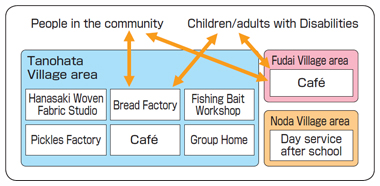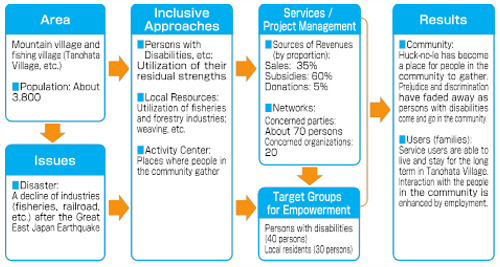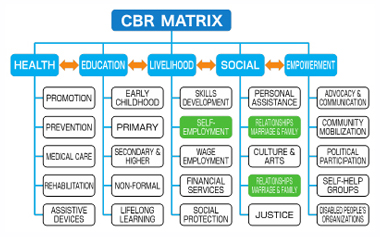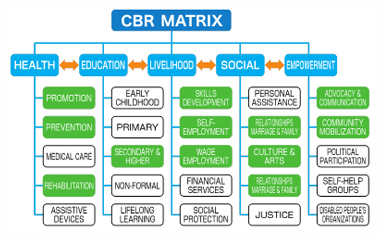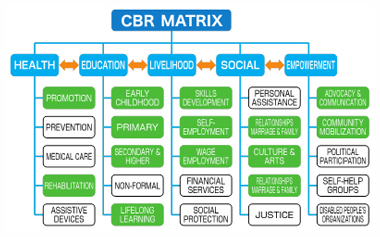Community-Based Inclusive Development
CBID Good Practices
Huck-no-Ie (Specified Non-profit Organization)
(Tanohata Village, Shimohei-gun, Iwate Prefecture)
Key Words Disasters, Open Land, Community Development
Huck-no-Ie started from the initiative of one housewife that soon involved the village head, medical doctors, municipal officers and other residents. This “endeavor to involve the surrounding community” has been reflected in our activities. It is not a one-sided interaction with others, but it involved itself with the surrounding community, as a result, responding to other community needs, such as establishing a place for older people to stay, support program for children with school phobia, home-based work for parents rearing children, etc. That is the amazing thing about Huck-no-Ie. It faced difficulties caused by the Great East Japan Earthquake but has surmounted these difficulties with the determination to involve the surrounding community, resulting in an opportunity to rediscover its own roots.
◆Background
There is only one welfare center in Tanohata Village. Before Huck-no-Ie began its operations, persons with disabilities in the village had no choice but to live in other regions, no matter how much they wished to remain there.
◆Service Outline
In April 1996, Huck-no-Ie was established as a community workshop with a goal to provide a barrier-free place for persons with disabilities. On its 10th anniversary, it became a specified non-profit organization. It engaged in the production of Hanasaki-woven fabric and pottery, commissioned to process marine products, as well as the production and sale of bread at a fully-equipped bakery and more. Providing the joy of productivity and a sense of purpose in the life of persons with disabilities promotes their social participation and independence.
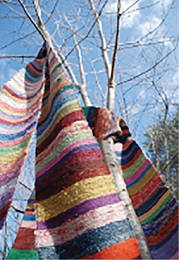
Basic Data
●Status: Located on a mountainous area, it is rich in nature, and edible wild plants can be collected at the hills behind Huck-no-Ie. The fisheries industry near the seashore was flourishing, but was significantly affected by the Great East Japan Earthquake.
●Coverage Area: In and around Tanohata Village, Iwate Prefecture (Fudai Village, Noda Village, Kuji City, etc.)
●Population: About 3,800
●Issues: There is only one community workshop in the three adjacent villages. The impact of the Great East Japan Earthquake can still be felt.
■Year of Establishment
It began as a community workshop in April 1996 and became a specified non-profit organization on March 2007.
■Contents of Services
●Objectives: To enable people with or without disabilities to live an ordinary life in the community
●Purpose of Services and Target Groups: The center mainly provides support to persons with disabilities, addressing issues in collaboration with the community. Thus, its target user is a wide range of people, from children to the elderly.
●Stakeholders: All the residents in Tanohata Village
●Main Source of Revenue: Remuneration from welfare services and sales of products (Hanasaki-woven fabric, pickles, bread, coffee, and fishing baits)
●What We Have Implemented: We have been providing services using existing community networks. People do not consider this place as one that specially provides support to persons with disabilities, but rather, they consider it as a place where people can gather spontaneously, weave when they have time, feel relaxed at the café, and enjoy conversation as they work. Since this place is never locked, anyone may enter freely, thereby creating a welcoming atmosphere. Many people come here and join us as they please.
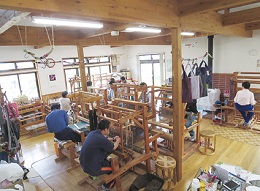
Members, community people and visitors visit and check out the Hanasaki Woven Fabric Studio.
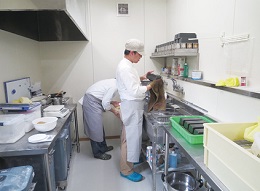
Two specialists at a washing place in Huck-no- le Bread Plant
■Special Festures
■Working on Individuals
Huck-no-Ie is good at finding the strengths of persons with disabilities who have various needs and personalities. In this diversified environment as variety of people in the community visit here, there is a mixture of strengths of disabled individuals and the surroundings, giving them peaceful and fulfilling days. For example, an autistic man who was socially unstable was provided work at the fishing bait assembly in a tranquil place where contact with others is limited. The man has adjusted himself well to the job, which utilized his gift of doing fine manual work. Another autistic man has a habit of writing news or stock quotations on a signboard at the café with a neat, typewriter-like handwriting. Now there are guests who visit the café just to see the signboard. These are just examples of how to recognize a personality trait as the key strength.
■Working with Communities
Since Huck-no-Ie is not a group of specialists, in many cases external advice is needed when they encounter problems. This is usually considered as a weakness of an organization. However, using this adverse situation, Huck-no-Ie makes it their strength by asking for assistance openly and involving the community, as a consequence its ties with the community has been strengthened. One good example is the construction of a hut for pottery making. When the organization decided to build this hut, they did not have the materials and equipment. Their appeal to the surrounding community resulted in the village head contributing timber from his own forest and a factory in the village lending heavy machineries. Furthermore, a nearby carpenter gave them professional advice, saying, “One pillar is lacking. This will not hold the building.” He sent a young apprentice carpenter to help them. In all, a total of 41 people in the community gave assistance free-of-charge until its completion. In other words, about one percent of the villagers participated in its construction. That is an extraordinary display of mobilizing power. Repeatedly involving the surrounding community in times of need enhanced ties with the community. Even elderly people nowadays participate in daytime activities such as pickle-making and helping pupils with school phobias as requested by the junior high-school. Thus, they, too, have become precious human resources for the community.
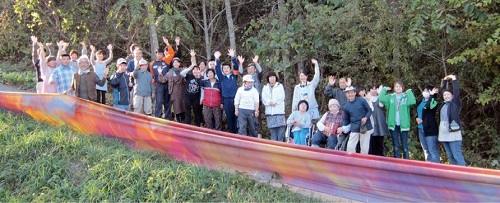
■“Even smiling is part of my job.”
Even if what a person can do is only to smile due to the severity of his disability, if his smile makes the atmosphere better or makes someone feel happy, then smiling deserves to be called work. Huck-no-Ie considers this as its philosophy. Weakness due to disabilities and characters that are sometimes regarded as troublesome are used as working opportunities and resources for the local community. There is a young man who likes explaining about the scenery to tourists in a train of Sanriku Railway even though it is unsolicited. His behavior might be regarded as annoying but every time a conductor mediates between him and tourists, all of them can have an enjoyable time. This shows that Huck-no-Ie’s philosophy is effective for the community.
“When I have difficulties, I say to others here and there, ‘I’m in trouble, I’m in trouble.’”
Being in trouble is normally a difficult time for an individual or an organization. It is generally assumed that the smaller the number of problems which cannot be tackled alone or within an organization, the better it is, and that issues should be resolved within the organization. In a way, Huck-no-Ie takes the opposite approach. Whenever it encounters a problem or an issue, it reaches out to the local community and often gets solutions from outside the organization. It may be a forced approach caused by the limitations of Huck-no-Ie, being a small organization with no specialists in it. However, by frequently opening up about its needs, Huck-no-Ie reminds the community of its existence and can, therefore, effectively utilize the resources of the community or society.
From the community’s viewpoint, Huck-no-Ie has become an entity that cannot be ignored. With the Great East Japan Earthquake as a turning point, it has carried out new programs utilizing a greater range of social welfare resources. Huck-no-Ie may have actually succeeded in stretching beyond itself.
◆How Things Changed
Before Huck-no-Ie was established, whenever someone in the community of Tanohata Village became disabled, it was impossible for that person to continue living in the area. Through a housewife’s involvement, the village head, medical doctors, municipal officers and residents came together and established Huck-no-Ie. Its original purpose was to allow persons with disabilities to continue living in Tanohata where they wish to live all their lives. However, as Huck-no-Ie continued their information campaign regarding their concerns, there evolved a mechanism to involve those who wanted to assist. These series of involvements have generated new activities in which people in various positions have made contributions to it.
In the Tanohata area, people’s level of acceptance of anyone is high. It has become natural to be supportive of each other in Huck-no-Ie, which is beyond their original expectations. For example, if a long queue is forming in a supermarket because someone is taking time to make a payment, the people waiting try to be patient or offer to help him. For a person who visits the bank regularly, the bank kindly assists him. For a person who acts as a tour guide without being asked in a train, the conductor kindly bridges him with the tourists. Such occasions have led the community to accept persons with disabilities. Now all the people involved with Huck-no-Ie sometimes go on a trip together to a hot spring resort.
The impact Huck-no-Ie has made in the community has caused a withdrawn young man to speak out about his interests, which means that his communication skills have improved, over and above getting an opportunity to work in this community. Similarly, issues of a junior high pupil with school phobia and some elderly who were not initially considered as target users of Huck-no-Ie, have been resolved through the presence of Huck-no-Ie in Tanohata Village.
The Great East Japan Earthquake caused great damage to the lives of people in this region, as well as to the environment and the industries. Huck-no-Ie was also affected, but it still continued disseminating information about the concerns of persons with disabilities. Tohoku district, which was affected most by the earthquake, came to the nation’s attention. Consequently, Huck-no-Ie received support from areas it had no links with before. It also began to address new community needs, such as finding places for children to stay while their parents are at work. Still, Huck-no-Ie continued to involve the surrounding community to solve problems especially because of the earthquake.
■Current lssues and Way Forward
The marine products processing factory, one of the most important industries, was lost due to the tsunami after the Great East Japan Earthquake. Huck-no-Ie would like to engage in something new. Since such needs as a daycare nursery for children with disabilities, support for the elderly, etc. not previously recognized by the community have now been identified, Huck-no-Ie considers it necessary to respond to these issues from now on.
■Analysis Using the CBR Matrix
◆Inauguration
At the time of inauguration, the first objective was to create an enabling community especially for those with disabilities. Therefore, it meant creating a place to stay, income opportunities and occasions for interaction.
◆Changes in the Lives of Individuals
The biggest fruit was the actualization of an enabling community, which was the first objective. However, the organization achieved more than that. Through their programs, the service users were able to maintain their health, generate income and find opportunities to interact. Its influence was felt not only by the original target user but also others. Elderly people needing preventive care and pupils with school phobia were benefited. Positive changes for such individuals change the community for the better as well.
◆Changes in Service Providers
The role of providing for those who needed to live in an enabling community has been fulfilled. The biggest end result we discovered is the power to involve the surrounding community, which is so characteristic of Huck-no-Ie. With that, in responding to various needs, the people behind Huck-no-Ie have fully integrated with the community.

